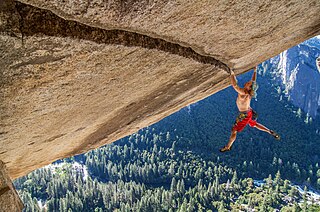
Climbing is the activity of using one's hands, feet, or other parts of the body to ascend a steep topographical object that can range from the world's tallest mountains to small boulders. Climbing is done for locomotion, sporting recreation, for competition, and is also done in trades that rely on ascension, such as construction and military operations. Climbing is done indoors and outdoors, on natural surfaces, and on artificial surfaces
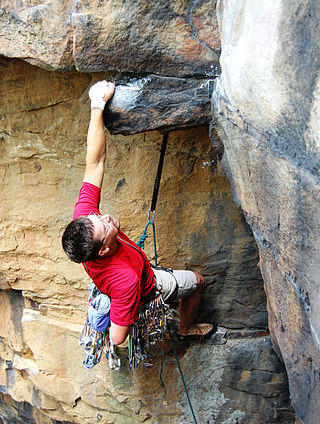
Traditional climbing is a type of free climbing in rock climbing where the lead climber places the protection equipment while ascending the route; when the lead climber has completed the route, the second climber then removes the protection equipment as they climb the route. Traditional climbing differs from sport climbing where the protection equipment is pre-drilled into the rock in the form of bolts.

Glossary of climbing terms relates to rock climbing, mountaineering, and to ice climbing.
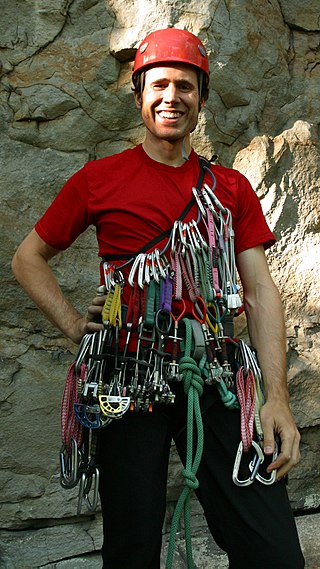
Rock-climbing equipment varies with the specific type of climbing that is undertaken. Bouldering needs the least equipment outside of climbing shoes, climbing chalk and optional crash pads. Sport climbing adds ropes, harnesses, belay devices, and quickdraws to clip into pre-drilled bolts. Traditional climbing adds the need to carry a "rack" of temporary passive and active protection devices. Multi-pitch climbing, and the related big wall climbing, adds devices to assist in ascending and descending fixed ropes. Finally, aid climbing uses unique equipment to give mechanical assistance to the climber in their upward movement.
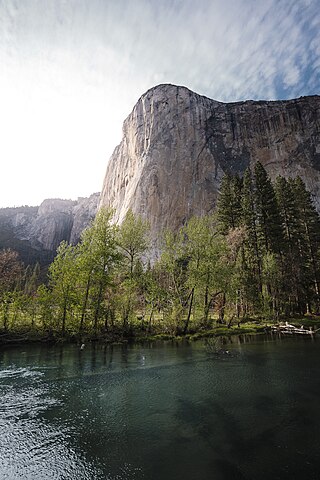
El Capitan is a vertical rock formation in Yosemite National Park, on the north side of Yosemite Valley, near its western end. The granite monolith is about 3,000 feet (914 m) from base to summit along its tallest face and is a world-famous location for big wall climbing, including the disciplines of aid climbing, free climbing, and more recently for free solo climbing.

Solo climbing, or soloing, is a style of climbing in which the climber climbs a route alone, without the assistance of a belayer or being part of a rope team. By its very nature, solo climbing presents a higher degree of risk to the climber, and in some cases, particularly where the climber is also not using any form of climbing protection, it is considered an extremely high-risk activity.
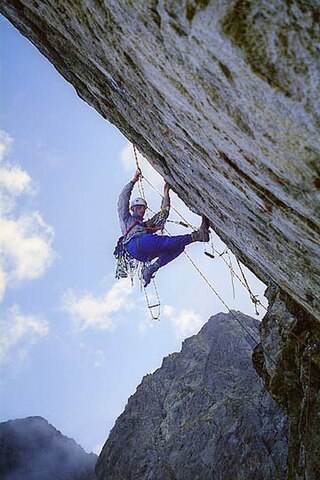
Aid climbing is a form of rock climbing that uses mechanical devices and equipment, such as aiders, for upward momentum. Aid climbing is contrasted with free climbing, which only uses mechanical equipment for protection, but not to assist in upward momentum. Aid climbing can involve hammering in permanent pitons and bolts, into which the aiders are clipped, but there is also 'clean aid climbing' which avoids any hammering, and only uses removable placements.

Sport climbing is a type of free climbing in rock climbing where the lead climber clips into pre-drilled permanent bolts for their protection while ascending a route. Sport climbing differs from the riskier traditional climbing where the lead climber has to insert temporary protection equipment while ascending.
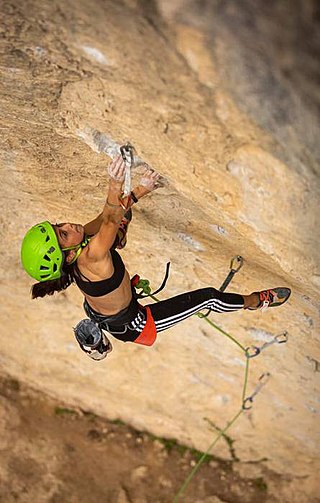
Lead climbing is a technique in rock climbing where the 'lead climber' clips their rope to the climbing protection as they ascend a pitch of the climbing route, while their 'second' remains at the base of the route belaying the rope to protect the 'lead climber' in the event that they fall. The term is used to distinguish between the two roles, and the greater effort and increased risk, of the role of the 'lead climber'.
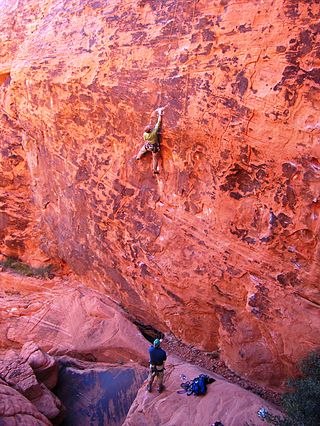
Top rope climbing is a form of rock climbing where the climber is securely attached to a climbing rope that runs through a fixed anchor at the top of the climbing route, and back down to the belayer at the base of the climb. A climber who falls will just hang from the rope at the point of the fall, and can then either resume their climb or have the belayer lower them down in a controlled manner to the base of the climb. Climbers on indoor climbing walls can use mechanical auto belay devices to top rope alone.
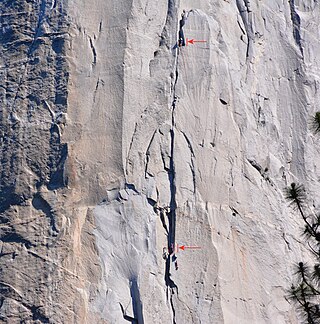
In climbing, a pitch is a section of a climbing route between two belay points, and is most commonly related to the task of lead climbing, but is also related to abseiling. Climbing on routes that require only one pitch is known as single-pitch climbing, and climbing on routes with more than one pitch is known as multi-pitch climbing.
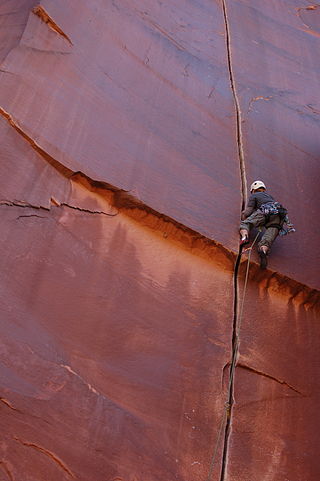
Rock climbing is a climbing sports discipline that involves ascending routes consisting of natural rock in an outdoor environment, or on artificial resin climbing walls in a mostly indoor environment. Routes are chronicled in guidebooks, and on online databases, with the details of how to climb the route, and who made the first ascent and the coveted first free ascent. Climbers will try to ascend a route onsight, however, a climber can spend years projecting a route before they make a redpoint ascent.

Multi-pitch climbing is a type of climbing that typically takes place on routes that are more than a single rope length in height, and thus where the lead climber cannot complete the climb as a single pitch. Where the number of pitches exceeds 6–10, it can become big wall climbing, or where the pitches are in a mixed rock and ice mountain environment, it can become alpine climbing. Multi-pitch rock climbs can come in traditional, sport, and aid formats. Some have free soloed multi-pitch routes.
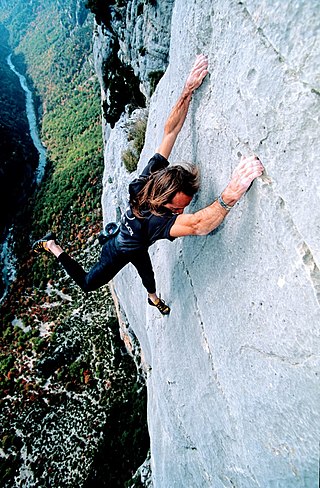
Free solo climbing, or free soloing, is a form of rock climbing where the climbers climb solo without ropes or other protective equipment, using only their climbing shoes and their climbing chalk. Free soloing is the most dangerous form of climbing, and, unlike bouldering, free soloists climb above safe heights, where a fall can be fatal. Though many climbers have free soloed climbing grades they are very comfortable on, only a tiny group free solo regularly, and at grades closer to the limit of their abilities.

In the history of rock climbing, the three main sub-disciplines – bouldering, single-pitch climbing, and big wall climbing – can trace their origins to late 19th-century Europe. Bouldering started in Fontainebleau, and was advanced by Pierre Allain in the 1930s, and John Gill in the 1950s. Big wall climbing started in the Dolomites, and was spread across the Alps in the 1930s by climbers such as Emilio Comici and Riccardo Cassin, and in the 1950s by Walter Bonatti, before reaching Yosemite where it was led in the 1950s to 1970s by climbers such as Royal Robbins. Single-pitch climbing started pre-1900 in both the Lake District and in Saxony, and by the late-1970s had spread widely with climbers such as Ron Fawcett (Britain), Bernd Arnold (Germany), Patrick Berhault (France), Ron Kauk and John Bachar (USA).

A Grigri is an assisted braking belay device manufactured by Petzl designed to help secure rock-climbing, rappelling, and rope-acrobatic activities. Its main characteristic is a clutch that assists in braking under a shock load. The success of this device has led to grigri becoming a common name for devices of this type. In 2011 a new version, the Grigri 2, was released to replace the original 1991 model. Petzl released the Grigri+ in 2017, adding safety features to the original design, however this added weight and many climbers felt the new safety features were more of a hindrance than a help. 2019 saw the release of an updated version of the device, simply called the Grigri. It is named for the African amulet gris-gris, believed to protect the wearer from evil.

Big wall climbing is a form of rock climbing that takes place on long multi-pitch routes that normally require a full day, if not several days, to ascend. In addition, big wall routes are typically sustained and exposed, where the climbers remain suspended from the rock face, even sleeping hanging from the face, with limited options to sit down or escape unless they abseil back down the whole route, which is a complex and risky action. It is therefore a physically and mentally demanding form of climbing.

Simul-climbing is a climbing technique where a pair of climbers who are attached by a rope simultaneously ascend a multi-pitch climbing route. It contrasts with lead climbing where the leader ascends a given pitch on the route while the second climber remains in a fixed position to belay the leader in case they fall. Simul-climbing is not free solo climbing, as the lead simul-climber will clip the rope into points of climbing protection as they ascend. Simul-climbing is different from a rope team and short-roping, which are used for flatter terrain that doesn't typically need protection points.

Catherine Destivelle is a French rock climber and mountaineer who is considered one of the greatest and most important female climbers in the history of the sport. She came to prominence in the mid-1980s for sport climbing by winning the first major female climbing competitions, and by being the first female to redpoint a 7c+/8a sport climbing route with Fleur de Rocaille in 1985, and an 8a+ (5.13c) route with Choucas in 1988. During this period, she was considered the strongest female sport climber in the world along with Lynn Hill, however, in 1990 she retired to focus on alpine climbing.

Alpine climbing is a type of mountaineering that uses any of a broad range of advanced climbing skills, including rock climbing, ice climbing, and/or mixed climbing, to summit typically large routes in an alpine environment. While alpine climbing began in the European Alps, it is used to refer to climbing in any remote mountainous area, including in the Himalayas and Patagonia. The derived term alpine style refers to the fashion of alpine climbing to be in small lightly equipped teams who carry their equipment, and do all of the climbing.






















